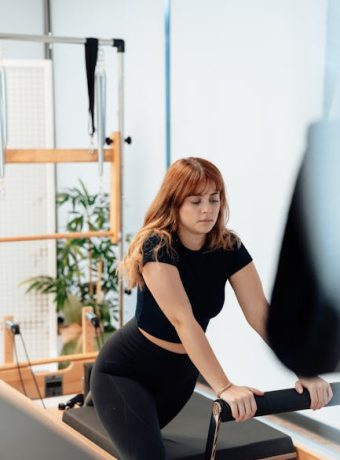Yoga for Women: A Comprehensive Guide to Starting Your Practice
Yoga has become a popular practice worldwide, known for its ability to enhance physical, mental, and emotional well-being. For women, in particular, yoga offers numerous benefits that can improve overall quality of life. Whether you’re a beginner or looking to deepen your practice, this comprehensive guide will provide you with all the information you need to start practicing yoga effectively.
The Benefits of Yoga for Women
Yoga is more than just a physical exercise; it’s a holistic approach to health and well-being. Here are some of the key benefits of yoga for women:
Physical Health
Yoga helps improve flexibility, strength, and balance. It can be particularly beneficial for women in various stages of life, from adolescence to menopause. According to a study published in the Journal of Physical Activity and Health, practicing yoga regularly can reduce the risk of chronic diseases such as hypertension, diabetes, and cardiovascular conditions.
Mental Health
Yoga is well-known for its mental health benefits. It can help reduce stress, anxiety, and depression. A study by the National Center for Complementary and Integrative Health found that yoga can significantly lower cortisol levels, the body’s primary stress hormone.
Emotional Well-being
Practicing yoga can enhance emotional resilience and foster a sense of inner peace. Techniques such as meditation and breathwork can help you become more mindful and present, which can improve your emotional health.
How to Start Your Yoga Practice
Starting a yoga practice can feel overwhelming, but it doesn’t have to be. Follow these steps to begin your journey:
Choose the Right Type of Yoga
There are various styles of yoga, each suited to different needs and preferences. Here are a few popular types:
- Hatha Yoga: A gentle introduction to the most basic yoga postures.
- Vinyasa Yoga: A dynamic flow that links breath with movement.
- Ashtanga Yoga: A rigorous style that follows a specific sequence of postures.
- Bikram Yoga: A series of 26 challenging postures practiced in a heated room.
- Yin Yoga: A slow-paced practice focusing on deep stretches and holding postures for longer periods.
Find a Qualified Instructor
While online tutorials and apps can be useful, having a qualified instructor can make a significant difference in your practice. Look for certified yoga instructors in your area or consider joining a reputable yoga studio.
Invest in the Right Gear
Having the right equipment can enhance your yoga practice. Here are some essentials:
- Yoga Mat: Provides cushioning and grip during postures.
- Yoga Blocks: Help with stability and alignment.
- Yoga Strap: Assists in stretching and achieving difficult poses.
- Comfortable Clothing: Allows for ease of movement.
Start with Basic Poses
If you’re new to yoga, start with basic poses that are easy to learn and perform. Here are a few beginner-friendly postures:
- Mountain Pose (Tadasana): A foundational standing pose that improves posture.
- Downward-Facing Dog (Adho Mukha Svanasana): A full-body stretch that strengthens the arms and legs.
- Child’s Pose (Balasana): A resting pose that helps release tension in the back and shoulders.
- Cat-Cow Pose (Marjaryasana-Bitilasana): A gentle flow that increases spinal flexibility.
- Warrior I (Virabhadrasana I): A standing pose that builds strength and stamina.
Tips for a Successful Yoga Practice
Maintaining a consistent yoga practice can be challenging, but these tips can help you stay on track:
Set Realistic Goals
Start with small, achievable goals. Whether it’s practicing for 10 minutes a day or attending a yoga class once a week, setting realistic goals will keep you motivated.
Create a Dedicated Space
Having a designated space for your yoga practice can make it easier to stay consistent. Choose a quiet, clutter-free area in your home where you can practice without distractions.
Listen to Your Body
Yoga is a personal practice, and it’s essential to listen to your body. Avoid pushing yourself too hard and take breaks when needed. Remember, it’s okay to modify poses to suit your level of flexibility and strength.
Stay Consistent
Consistency is key to reaping the benefits of yoga. Try to practice regularly, even if it’s just for a few minutes each day. Over time, you’ll notice significant improvements in your physical and mental well-being.
Common Challenges and How to Overcome Them
Starting a yoga practice comes with its set of challenges. Here’s how to overcome some common obstacles:
Lack of Time
Many women struggle to find time for yoga amidst their busy schedules. To overcome this, try incorporating short yoga sessions into your daily routine. Even a 10-minute practice can make a difference.
Difficulty Staying Motivated
It’s natural to lose motivation over time. To stay inspired, try joining a yoga community or finding a yoga buddy. Sharing your progress and challenges with others can keep you motivated.
Physical Limitations
If you have physical limitations or injuries, it’s essential to modify your practice accordingly. Consult with a healthcare professional and work with a qualified yoga instructor to find poses that are safe and suitable for you.
Advanced Practices: Taking Your Yoga to the Next Level
Once you’ve established a regular practice, you may want to explore more advanced techniques. Here are some ways to deepen your practice:
Explore Advanced Poses
As you gain strength and flexibility, you can start incorporating more advanced poses into your practice. Examples include Crow Pose (Bakasana), Headstand (Sirsasana), and Wheel Pose (Urdhva Dhanurasana).
Incorporate Meditation
Meditation is an integral part of yoga that can enhance your mental and emotional well-being. Start with short, guided meditations and gradually increase the duration as you become more comfortable.
Practice Pranayama
Pranayama, or breath control, is a powerful technique that can improve your overall health. Techniques such as Nadi Shodhana (Alternate Nostril Breathing) and Kapalabhati (Skull Shining Breath) can help you manage stress and boost energy levels.
Conclusion
Yoga is a transformative practice that offers numerous benefits for women. By understanding the different styles of yoga, setting realistic goals, and staying consistent, you can create a fulfilling and sustainable yoga practice. Remember to listen to your body and seek guidance from qualified instructors as you embark on this journey to better health and well-being.
Whether you’re a beginner or looking to deepen your practice, yoga can be a valuable addition to your life. Start today, and experience the profound benefits that yoga has to offer.


